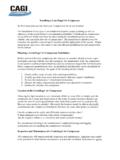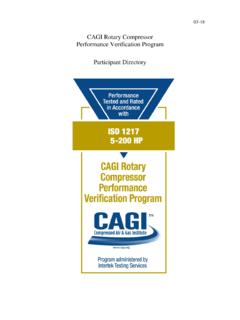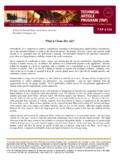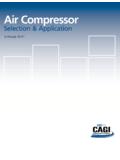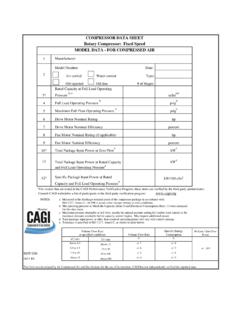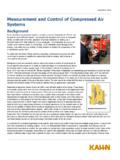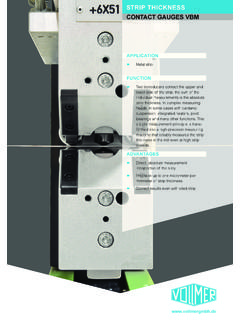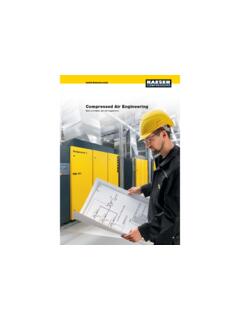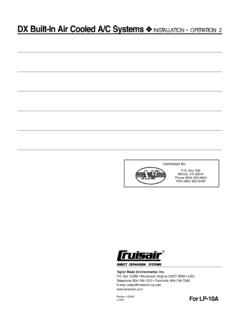Transcription of Compressed AirGas and Drying - CAGI
1 Compressed Airand GasDryingCONTENTSI. Why Do Compressed Air And Gas Need Drying ?1II. Applications Requiring Clean, Dry Air1 III. How To Measure Moisture Content2IV. Selecting The Right Dryer3V. Types Of Compressed Air Dryers4 Refrigerant TypeRegenerative Desiccant TypeHeat of Compression TypeSingle Tower Deliquescent TypeMembrane TypeVI. Specifying A Compressed Air Dryer7 VII. What Is A Compressed Air Drying System?9 VIII. Additional Literature10 Appendices11-13 IIIWHYDOCOMPRESSEDAIRANDGASNEEDDRYING?MO ISTUREISALWAYSPRESENT. All atmospheric air contains some water vaporwhich will begin to condense into liquid water inthe Compressed air or gas system when the air orgas cools past the saturation point, , the pointwhere it can hold no more water vapor.
2 * The temperature at which this happens is knownas the dew point.** This dew point becomes all-important in determining how much Drying is in the Compressed air system wouldoccur at the inlet air saturation temperature if tem-perature remained constant as air was , since there is a rise in temperature duringactual compression, condensation generally isavoided withinthe compressor. Later, as com-pressed air is discharged and cooled in an aftercool-er, condensation begins to occur. The condensedmoisture must be removed by a separator and air leaving the aftercooler normally is saturatedat the aftercooler discharge many years, problems from moisture in airlines were tolerated.
3 To prevent freezing, alcoholswere injected into the lines and electric heaterswere used during cold periods. Filters were used toseparate moisture and other contaminants but didnot completely solve the increased use of Compressed air and the devel-opment of many new and more sophisticateddevices and controls have accelerated the need forclean dry air. Hence, Drying technology advanced,and dryers came into general in Compressed air used in a manufacturingplant causes problems in the operation of pneumaticair systems, solenoid valves and air motors. Thismoisture causes rust and increased wear of movingparts as it washes away adversely affects the color, adherence, andfinish of paint applied by Compressed air.
4 Moisture jeopardizes process industries wheremany operations are dependent upon the properfunctioning of pneumatic controls. The malfunc-tioning of these controls due to rust, scale, andclogged orifices can result in damage to product orin costly shutdowns. Additionally, the freezing ofmoisture in control lines in cold weather commonlycauses faulty operation of controls. Corrosion of air or gas operated instruments frommoisture can give false readings, interrupting orshutting down plant , DRYAIRPLANTAIRIn almost every operation, clean, dry Compressed airwill result in lower operating costs. Dirt, water andoil entrained in the air will be deposited on the innersurfaces of pipes and fittings, causing an increase inpressure drop in the line.
5 A loss of pressure is a lossof the energy used to compress the air and a reducedpressure at the point of use results in a loss of performance efficiency. Liquid water accelerates corrosion and shortens theuseful life of equipment and carry over of corrosionparticles can plug valves, fittings and instrumentcontrol lines. When water freezes in these compo-nents, similar plugging will ANDCYLINDERSD eposits of sludge formed by dirty, wet and oily airact as a drag on pneumatic cylinders so that the sealsand bearings need frequent maintenance. Operationis slowed down and eventually stopped. Moisturedilutes the oil required for the head and rod of an aircylinder, corrodes the walls and slows response.
6 Thisresults in loss of efficiency and flowing to rubber diaphragms in valvescan cause these parts to stiffen and also can cause spools and pistons to high-speed production, a sluggish or stuckcylinder could create costly downtime. A clean, dry air supply can prevent many of these tools are designed to operate withclean, dry air at the required pressure. Dirty andwet air will result in sluggish operation, more frequent repair and replacement of parts due tosticking, jamming and rusting of wearing also will wash out the required oils, result-ing in excessive wear. A decrease in pressure at the tool caused by restrict-ed or plugged lines or parts will cause a reductionin the efficiency of the , dry air at the required pressure will enablethe production worker to start operating immedi-ately at an efficient level, with no time lost to purgelines or drain filters and will help to maintain pro-ductivity and prolong tool air supplied to transmitters, relays, inte-grators, converters, recorders, indicators or gaugesis required to be clean and dry.
7 A small amount ofmoisture passing through an orifice can cause * The maximum water vaporthe air can hold dependsupon the temperature andpressure. The amount ofvapor the air actually doescontain - relative to themost it can contain is rela-tive humidity (the ratio ofthe quantity of water vaporpresent to the quantitypresent at saturation at thesame temperature).** Dew Point. The tempera-ture at which water vaporin the air starts to con-dense or change fromvapor to a liquid or a solidstate. (Dew points may beexpressed at an operatingpressure or at atmosphericpressure. Operating pres-sure should be specifiedwhen using pressure dewpoint. The relationshipbetween pressure andatmosphere dew point isshown on Chart No.)
8 3 inthe ANDGASDRYING1 IIImalfunction of the instrument and the process itcontrols. Moisture and resultant corrosion particlesalso can cause damage to instruments and plugtheir supply air thermostats, which control the heatingand air conditioning cycles in large and smallbuildings, also require clean, dry and pneumatic controllers in powerplants, sewage treatment plants, chemical andpetrochemical plants, textile mills and general manufacturing plants, all need clean, dry air forefficient Instrument Society of America (ISA) has pub-lished Quality Standard for Instrument OFPRODUCTSWhen used to mix, stir, move or clean a product, airmust be clean and dry.
9 Oil and water in compressedair used to operate knitting machinery will cause thetiny latches on the knitting needles to stick. Whenused to blow lint and thread off finished fabrics, con-taminants in the air may cause product air is used to blow a container clean before pack-aging, entrained moisture and oil may contaminatethe product. Moisture in control line air can causethe wrong mixture of ingredients in a bakery, theincorrect blend in liquor, water-logged paint, orruined food some printing operations, air is used to lift orposition paper, which will be affected by dirty, wetair and any water on the paper will prevent properadhesion of the pneumatic conveying of a product such as papercups or cement, dry air is wind tunnels are designed to simulateatmospheric conditions at high altitudes wheremoisture content is low.
10 These chambers use largevolumes of air, which must be dried to a very lowdew point to prevent condensation in the tunnelair air coming from an air compressor, whetherlubricated or oil free type, is not suitable for breath-ing. Treatment of the air is required before the aircan be considered suitable for breathing and certainhealth and safety standards must be industrial plants, air may be supplied to respira-tors, hoods and helmets and for applications suchas sand blasting. Occupational Safety and HealthAdministration (OSHA) standard OSHA:1910:13dapplies and requires Drying , filtration and treat-ment to meet specific levels, including carbonmonoxide, with an alarm Compressed Gas Association (CGA) StandardCommodity Specification , Grade D, common-ly is specified for plant breathing air air for hospitals must meet National FireProtection Association (NFPA) Standard Quality Classesencompassing pollutants havebeen established in an International Standard ISO8573-1.


